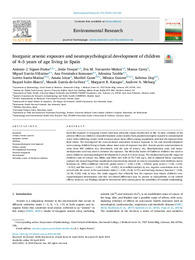Título :
Inorganic arsenic exposure and neuropsychological development of children of 4–5 years of age living in Spain |
Autor :
Signes-Pastor, Antonio Jose 
Vioque, Jesús
Navarrete-Muñoz, Eva María
Carey, Manus 
García Villarino, Miguel 
Fernández Somoano, Ana
Tardón, Anodina
SANTA MARINA, LORETO 
Irizar, Amaia 
Casas, Maribel 
Guxens, Mònica 
Llop, Sabrina
Soler-Blasco, Raquel 
Garcia de la Hera, Manuela 
Karagas, Margaret R 
Meharg, Andrew A. |
Editor :
Elsevier |
Departamento:
Departamentos de la UMH::Salud Pública, Historia de la Ciencia y Ginecología |
Fecha de publicación:
2019 |
URI :
https://hdl.handle.net/11000/30789 |
Resumen :
Early-life exposure to inorganic arsenic (iAs) may adversely impact health later in life. To date, evidence of iAs adverse effects on children's neurodevelopment comes mainly from populations highly exposed to contaminated water with conflicting results. Little is known about those effects among populations with low iAs exposure from food intake. We investigated the cross-sectional association between exposure to iAs and neurodevelopment scores among children living in Spain whose main route of exposure was diet. Arsenic species concentrations in urine from 400 children was determined, and the sum of urinary iAs, dimethylarsinic acid, and monomethylarsonic acid was used to estimate iAs exposure. The McCarthy Scales of Children's Abilities was used to
assess children's neuropsychological development at about 4–5 years of age. The median (interquartile range) of children's sum of urinary iAs, MMA, and DMA was 4.85 (2.74–7.54) μg/L, and in adjusted linear regression analyses the natural logarithm transformed concentrations showed an inverse association with children's motor
functions (β, [95% confidence interval]; global scores (−2.29, [-3.95, −0.63])), gross scores (−1.92, [-3.52, −0.31]) and fine scores (−1.54, [-3.06, −0.03]). In stratified analyses by sex, negative associations were observed with the scores in the quantitative index (−2.59, [-5.36, 0.17]) and working memory function (−2.56, [-5.36, 0.24]) only in boys. Our study suggests that relatively low iAs exposure may impair children's neuropsychological
development and that sex-related differences may be present in susceptibility to iAs related effects; however, our findings should be interpreted with caution given the possibility of residual confounding.
|
Palabras clave/Materias:
Urinary arsenic species
Inorganic arsenic
Children
Neuropsychological development
Dietary arsenic
Developmental toxicology
Neurodevelopment
Environment
McCarthy scales of Children's abilities |
Tipo de documento :
info:eu-repo/semantics/article |
Derechos de acceso:
info:eu-repo/semantics/openAccess
Attribution-NonCommercial-NoDerivatives 4.0 Internacional |
DOI :
https://doi.org/10.1016/j.envres.2019.04.028 |
Aparece en las colecciones:
Artículos Salud Pública, Historia de la Ciencia y Ginecología
|

 La licencia se describe como: Atribución-NonComercial-NoDerivada 4.0 Internacional.
La licencia se describe como: Atribución-NonComercial-NoDerivada 4.0 Internacional.
.png)